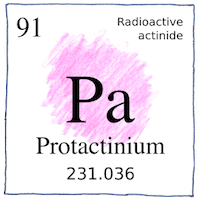Karlsruhe, Glasgow, Berlin—Oswald Helmuth Göhring,
Georg von Hevesy,
John Arnold Cranston,
Frederick Soddy,
Otto Hahn,
Lise Meitner
elements

|
Protactinium
Kasimir Fajans and Oswald Helmuth Göhring found protactinium-234 and named it brevium. John Arnold Cranston and Frederick Soddy found a stable isotope of protactinium and didn’t announce it until after WWI. Otto Hahn and Lise Meitner found protactinium-231 and named it proto-actinium.
Atomic number 91
Uranium-235 from nuclear reactors decays to protactinium-231. Uranium-238 to protactinium-234m, a nuclear isomer. Thorium-233 decays to protactinium-233. Relative amounts of isotopes of uranium, thorium, and protactinium help determine the ages of geological processes
Eating it
Protactinium—rare but everywhere, in our water, in our food, in our air. Extremely toxic, promoting cancer, though a small part stays to answer. Over time, let us see; it decays, and so do we.



Protractinium is highly radioactive and extremely toxic, so even though its oxides and other chemical compounds have a variety of colors and crystal structures, you won’t see it advertised in tomorrow’s dinnerware or playthings, although it might well be there.
See also in The book of science:
Readings in wikipedia:
Other readings: